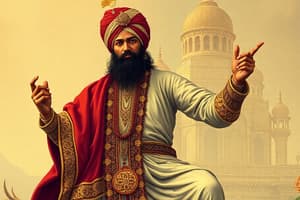Podcast
Questions and Answers
What is the English translation of the term 'Parkash'?
What is the English translation of the term 'Parkash'?
- Manifestation
- Illumination (correct)
- Persecution
- Religious ceremony
Which event marks the emergence of Sikhism as an organized religion?
Which event marks the emergence of Sikhism as an organized religion?
- Presentation of swords by Gobind Singh
- Formation of the Khalsa Panth (correct)
- Martyrdom of Guru Tegh Bahadur
- Initiation ceremony of Amrit Sanchar
Who became the tenth and last living human Guru of Sikhi after Guru Tegh Bahadur?
Who became the tenth and last living human Guru of Sikhi after Guru Tegh Bahadur?
- Jathedar
- Aurangzeb
- Gobind Singh (correct)
- Sarbat Kyote Da
What did Gobind Singh present to five warriors at Anandpur Sahib in 1700?
What did Gobind Singh present to five warriors at Anandpur Sahib in 1700?
Which term means introduction or starting point in the context of Sikh history?
Which term means introduction or starting point in the context of Sikh history?
What does Vaisakhi commemorate annually?
What does Vaisakhi commemorate annually?
From a sociological standpoint, what does Parkash Ka Pravartan reflect?
From a sociological standpoint, what does Parkash Ka Pravartan reflect?
How is the transformation discussed in the text viewed through psychological processes?
How is the transformation discussed in the text viewed through psychological processes?
What does Parkash Ka Pravartan embody?
What does Parkash Ka Pravartan embody?
What insight does Parkash Ka Pravartan provide according to the text?
What insight does Parkash Ka Pravartan provide according to the text?
Flashcards are hidden until you start studying
Study Notes
Parkash Ka Pravartan: A Journey of Enlightenment
In the vast tapestry of Indian culture, a significant event known as Parkash Ka Pravartan marks a pivotal moment where the Sikh faith emerged from its formative stages into an organized religion. To understand this phenomenon fully, let's delve into its historical roots and scientific perspectives.
Historical Background
The term "Parkash" translates literally to manifestation or illumination, while "Pravartan" means introduction or starting point. On a fateful day in September 1699, Guru Tegh Bahadur—the ninth Sikh Guru—was martyred by Mughal Emperor Aurangzeb because he had refused to convert to Islam. His son, Gobind Singh, became the tenth and last living human Guru of Sikhi. In response to increasing persecution against Hindus and Sikhs under Mughal rule, Gobind Singh called for the amalgamation of his followers through the initiation ceremony of Amrit Sanchar. This act ultimately led to the formation of the Khalsa Panth, a collective body within Sikhism committed to preserving their distinct identity.
On March 30, 1700, at Anandpur Sahib, near modern-day Punjab, India, Gobind Singh presented five warriors with swords, symbolizing them as leaders of the faithful who would defend both truth and justice. These men were given the surnames Singh (lion), Kaur (princess), and titles like Jathedar (leader) and Sarbat Kyote Da (belonging to all). This occasion is celebrated annually as Vaisakhi, also commemorating the Sikh New Year.
While the Khalsa was initially formed out of necessity during the tumultuous times of religious intolerance, it evolved into an enduring tradition and integral component of Sikh life.
Scientific Perspective
From a sociological standpoint, Parkash Ka Pravartan reflects the emergence and evolution of social phenomena such as cohesive group identities, ritual practices, adaptive responses, organizational structures, and leadership roles. It illustrates how the desire to maintain cultural integrity and protect communities can fuel the creation of new institutions and customs. Moreover, one could argue that this event marked the genesis of a novel cultural movement, eventually spreading beyond ethnic lines and geographical boundaries.
Furthermore, this transformation can be viewed through the lens of psychological processes, including the rise of self-identity and intra-group solidarity among early converts of the newly established order. One may even consider the dynamic nature of conflict resolution strategies employed by Gobind Singh as an example of strategic thinking. Ultimately, Parkash Ka Pravartan embodies the complex interplay between spirituality, politics, and society, providing fertile ground for scholarly exploration across numerous academic disciplines.
To summarize, Parkash Ka Pravartan signifies more than just a single historical event; rather, it encapsulates the gestation and growth of Sikh identity, offering valuable insights into various facets of human experience and behavior.
Studying That Suits You
Use AI to generate personalized quizzes and flashcards to suit your learning preferences.




